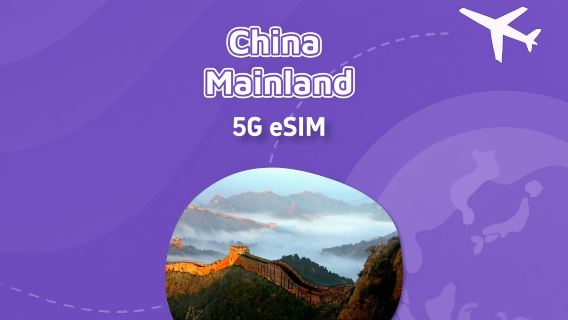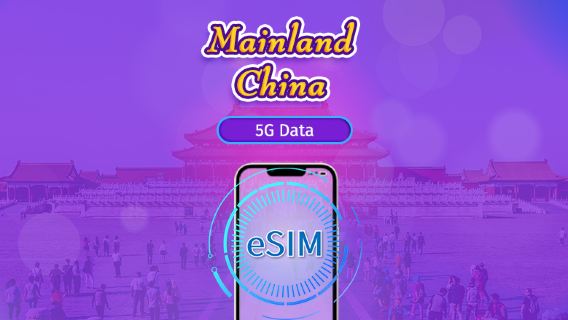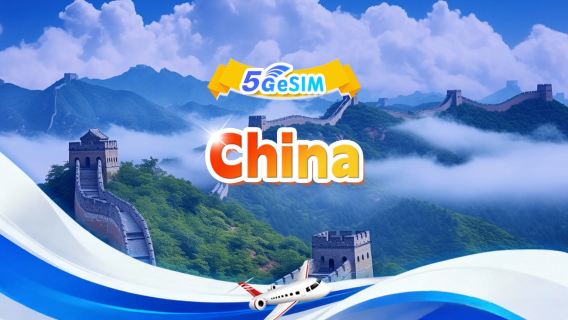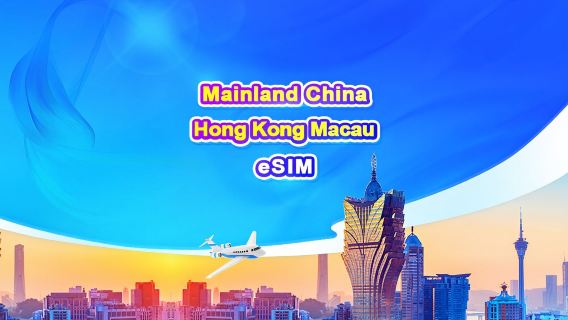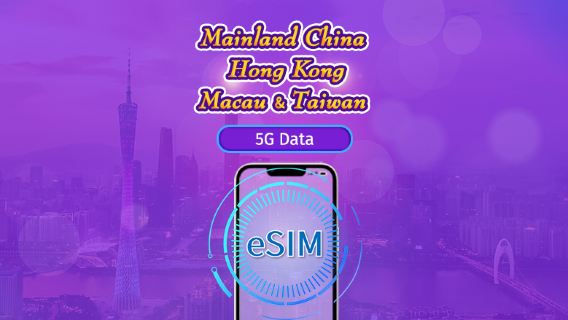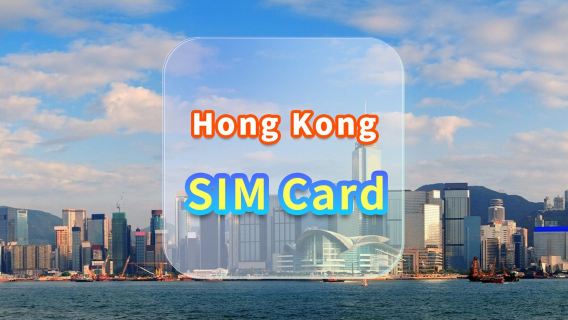
To travel around China by train, you first need to know about China’s 10 train types, from the fast G-series EMUs (which can reach speeds of over 300 km/h or 186 mph) to the affordable ordinary trains. Each letter code - G, D, C, Z, T, K, Y, L, S - represents a different speed, amenities and price level.
This article will help you clarify your ideas and choose the appropriate train type based on your travel needs: choose G/D for efficient intercity travel, K/T for affordable regional travel, and Y/Z for scenic routes. Whether you are looking for speed or cost savings, understanding these train types will ensure that you book your trains more wisely and enjoy a smoother journey when travelling in China.
Search China Cheap Train Tickets
[Save 3%] China Train Ticket Discount for New Users
24/7 Ticketing · 3-Minute Booking · E-Tickets
🏷️Find Cheap Flights, Hotels, Train Tickets, and eSIMs & SIM Card for Your China Trip
🔥 Selected China Train Routes for Travellers
| Train Route | Duration | Book Online |
|---|---|---|
| Hong Kong to Guangzhou | 47m | Book Ticket |
| Hong Kong to Shenzhen | 14m | Book Ticket |
| Guangzhou to Shenzhen | 29m | Book Ticket |
| Shanghai to Hangzhou | 39m | Book Ticket |
| Shanghai to Suzhou | 23m | Book Ticket |
| Chengdu to Chongqing | 1h 2m | Book Ticket |
| Shanghai to Nanjing | 1h 38m | Book Ticket |
| Beijing to Tianjin | 1h 2m | Book Ticket |
| Wuhan to Changsha | 1h 11m | Book Ticket |
| Train Route | Duration | Book Online |
|---|---|---|
| Beijing to Shanghai | 4h 18m | Book Ticket |
| Beijing to Xi'an | 4h 10m | Book Ticket |
| Hong Kong to Beijing | 8h 10m | Book Ticket |
| Hong Kong to Shanghai | 8h 6m | Book Ticket |
| Beijing to Guangzhou | 7h 17m | Book Ticket |
| Beijing to Chengdu | 7h 30m | Book Ticket |
| Shanghai to Chengdu | 11h 11m | Book Ticket |
| Beijing to Harbin | 4h 47m | Book Ticket |
| Beijing to Kunming | 10h 55m | Book Ticket |
China Train Types: What's the Difference Between G/D/C/Z/T/K Trains in China?

When travelling by train in China, have you ever noticed the train codes on your ticket that begin with the letters G, D, C, Z, etc.? These mysterious letters actually represent different types of trains in the Chinese railway system, each with significant differences in running speeds, stops, fares, and services. From the "G" high-speed trains that can reach speeds of up to 350 kilometres (217 miles) per hour to the affordable "K" express trains, understanding the meaning behind these codes will help you choose the best way to travel, saving time and staying within your budget.
Fortunately, when you book your train tickets with Trip.com, you don't have to worry about the language barrier at all. With English support and mobile e-tickets, Trip.com makes travelling in China easy and convenient - no more trying to decipher Chinese tickets!
Code | Type | Speed (mph) | Key Features |
High Speed Type | |||
G | High-Speed Rail | 186–217 | Fastest, fewest stops |
D | Electric Multiple Unit | 124–155 | Connects mid-sized cities |
C | Intercity EMU | 99–124 | Short-distance routes (e.g., Shanghai-Hangzhou) |
Normal Type | |||
Z | Direct Express | 75–99 | Overnight, limited stops |
T | Express Train | 75–87 | More stops than Z trains |
K | Fast Train | 62–75 | Frequent stops, budget-friendly |
Y | Temporary Tourist Train | 50–87 | Designed for tourist routes |
L | Temporary Passenger | 50–87 | Extra services during peak travel seasons |
S | Suburban Railway | 62–100 | Commuter routes (e.g., Huairou to Miyun trains) |
– | Ordinary Train | 62-75 | Basic service, cheapest option |
G Trains: High-Speed Rail / Gaotie

G-trains are China's fastest bullet trains, with speeds of 300-350 km/h (186-217 mph). In China, high-speed rail is the fastest way to travel by land between major cities. These trains use advanced technology to ensure maximum speed and safety.
Passengers can choose between business Class (luxury 2+1 seats), first Class (comfort 2+2 seats) and second Class (economy 3+2 seats). All classes are equipped with power sockets, Wi-Fi and air conditioning and other convenient infrastructure. In addition, some high-speed trains also provide baby changing tables and barrier-free carriages. Although high-speed rail fares are higher than other trains, they save a lot of time and are very suitable for business travellers and tourists who value speed. The smooth ride and modern facilities make even a 4-5 hour journey unexpectedly comfortable.
China's high-speed rail mainly connects major domestic cities through a dedicated high-speed railway network, the most representative of which include Beijing to Shanghai (4.5 hours) and Guangzhou to Shenzhen (29 minutes).
D Trains: Electric Multiple Unit / Dongche

As high-speed EMUs, D trains can run at speeds of 200-250 km/h (124-155 mph), which is slightly lower than G-class trains but still much faster than traditional railways, and are an important addition to China's high-speed rail network.
In terms of seating configuration, D trains offer business class (rare), first class (2+2 seats) and second class (3+2 seats) similar to G trains, but with relatively less legroom. However, their ticket prices are about 20-30% lower than similar G trains, making them particularly popular with budget-conscious travellers and students. It is worth mentioning that modern carriages are still equipped with power sockets and comfortable seats to ensure a good journey experience within 4 hours.
In particular, some long-distance D trains (i.e., sleeper trains) also offer sleeper options. Compared with traditional trains, these sleeper trains have more advanced facilities and are usually equipped with 4-6-person private rooms. For example, the sleeper train from Beijing to Xi'an is a good choice - passengers can depart at night, sleep comfortably, and start exploring the destination in the morning.
D trains mainly undertake regional connection functions, such as important intercity routes such as Shanghai to Hangzhou (60 minutes) and Chengdu to Chongqing (90 minutes), effectively filling the service gap of the high-speed rail network.
C Trains: Intercity Trains

C trains are designed for short trips between nearby cities and run at speeds of 160-200 km/h (99-124 mph). These efficient trains bridge the gap between metro and long-distance rail services.
Most C trains offer only spacious 2+2 seats in second class. With affordable fares and frequent departures, they're perfect for commuters and day-trippers. While the facilities are basic compared to the high-speed rail, the journey is still comfortable within 2 hours.
Typical examples include the Shanghai-Hangzhou Intercity Train (10 minutes), the Beijing-Tianjin Intercity Train (30 minutes) and the Guangzhou-Zhuhai Intercity Train (60 minutes), connecting economically integrated city clusters.
Z Trains: Direct Express

Image source: Wikipedia
Z trains (120-160 km/h or 75-99 mph) are overnight services with minimal stops between major cities. They offer the fastest conventional rail option for long-distance travel.
These trains offer soft sleepers (4-berth), hard sleepers (6-berth), and hart seat options. While slower than bullet trains, they provide cost-effective overnight travel with substantial time savings over other conventional trains. Popular with budget travellers making long journeys.
If I have to recommend some features and tourist routes of Z trains, I would recommend the Z train to Lhasa:
Shanghai to Lhasa (Z164/Z265)
Z164 is the best choice for first-time visitors to Tibet, because it has a high coverage of landscapes during the day and complete measures to deal with plateau sickness. The Golmud to Lhasa section of the Qinghai-Tibet Railway runs during the day to ensure that you don't miss the plateau wonders at an altitude of 5,000 meters, including Qinghai Lake, the Hoh Xil No Man's Land, and the Tanggula Pass. Take the train through the Kunlun Mountains, Tuotuo River, and the northern Tibetan grasslands, and you can see wild animals such as Tibetan antelopes along the way.
The train journey from Shanghai to Lhasa is about 45 hours, and the reference fare for hard sleeper tickets starts at 793.5 yuan. In addition, the carriages are supplied with oxygen throughout the journey to relieve altitude sickness. The scenery reaches its climax after transferring to the plateau train at Xining Station.
Guangzhou to Lhasa (Z264/Z266)
If you are a photography enthusiast, I recommend starting from Guangzhou. This is the largest north-south route into Tibet in China, from the Lingnan water town through the heart of the Central Plains to the snowy plateau, a total of 4,980 kilometres, where you can experience the gradual change of geographical landscape. The journey takes about 53 hours 39 minutes, and the reference fare for hard sleeper is 865 yuan. You can also enjoy the dual views of the Jiangnan rapeseed sea and the plateau snow-capped mountains in March!
Xining to Lhasa (Z8981/Y971)
If time is tight, you can start from Xining and go directly to the essence of the Qinghai-Tibet line, which is more cost-effective. The journey (21 hours 15 minutes) is suitable for travellers with limited time, and the lowest fare is only 224 yuan (hard seat). There are iconic landscapes such as Qinghai Lake, Hoh Xil, and Nyainqentanglha Mountain, and the whole journey is high-density plateau scenery.
Note: All trains entering Tibet will replace the plateau car body at Xining Station and start diffuse oxygen supply. It is recommended to choose a sleeper, which is more comfortable for long-distance travel, and the windows of the hard sleeper car are more convenient for viewing.
T Trains: Express Train

Operating at 120-140 km/h (75-87 mph), T trains are faster than regular trains but make more stops than Z trains.
Train seats include soft seats, hard seats, and sometimes sleeper berths. These trains are cost-effective, combining speed and economy. They're favoured by domestic travellers making medium-distance journeys of 6–10 hours.
The important T train routes connect cities like Beijing-Shanghai (15 hours) and Xi'an-Lanzhou (7 hours), serving regional transportation needs.
K Trains: Fast Train

K trains (100-120 km/h or 62-75 mph) are China's standard fast trains, making frequent stops at smaller stations along the way.
These affordable trains mainly offer hard seats, hard sleeper and soft sleeper carriages and are equipped with basic facilities. Although the journey time is longer, the low ticket prices attract students and cost-conscious travellers. The frequent stops make it easy to travel to smaller cities not covered by high-speed trains.
Typical routes include Guangzhou → Chongqing (19 hours) and Xi'an → Lanzhou (8 hours) and Shanghai → Guilin (24 hours), connecting provincial capitals with surrounding regions.
S Trains: Suburban Railway

S trains (80-120 km/h or 50-75 mph) serve commuter routes in major metropolitan areas, operating similarly to regional rail systems.
With simple seating and high capacity, these trains offer affordable fares for daily commuters. Most trains use prepaid transportation cards or mobile apps to scan QR codes instead of traditional tickets. They are essential for suburban residents who work in the city centre.
Major lines include Beijing Suburban Railway Line S2 (Beijing-Yanqing Line), which takes tourists to Badaling, and Line S5 (Huairou-Miyun Line), which is mainly a daily commuting route for suburban residents.
Ordinary Trains (Number Series)

Ordinary trains, that is, common green trains, usually have a 4-digit number (1XXX~8XXX). They are the slowest trains in China (100-120 km/h or 62-75 mph), make the most stops and offer the most basic facilities. They serve as the backbone of rural transportation.
These simple trains usually only have hard seats, hard sleepers and soft sleepers, and have simple facilities. While not comfortable for long journeys, they provide vital transport links to remote areas at minimal cost.
They primarily operate on less-travelled routes like Jiayuguan – Dunhuang (7535, 6 h 21 m) and Urumqi – Kashgar (7556, 25 hours), serving China's vast interior regions.
Other Train Types in China

In the Chinese railway system, in addition to the common mainstream train types such as G, D, C, Z, T and K, there are also special trains with Y and L train. Because these types of trains are less frequently used in regular travel, here we will briefly introduce these two more special train types:
Y trains (tourist trains) are special trains opened by China Railway for special tourist routes, mainly running during the peak tourist season, such as Xining to Lhasa (Y971). These trains usually connect famous tourist attractions, such as the "Silk Road" train and the "Northeast Ice and Snow" train. Some carriages will be themed and provide special catering and services, which is a good choice for in-depth tours.
L trains (temporary passenger trains) are trains temporarily added by the railway department during peak passenger flow periods such as the Spring Festival and Summer Travel. Most of them are ordinary trains with many stops. The ticket price is relatively cheap, but the comfort level is average. Since the train schedules are not fixed, tourists need to pay attention to the temporary announcements of the railway department in advance to obtain specific operation information. For foreign tourists, the distinctive Y tourist train may be more worth experiencing.
China Train Types FAQs
What is the difference between China's high-speed rail (G train) and EMU (D train)?
High-speed rail (G train) is the fastest train (300-350km/h or 186–217 mph) and runs on dedicated tracks; EMU (D train) is slightly slower (200-250km/h or 124–155 mph) and can run on ordinary tracks.
What is the difference between a train and an EMU?
Traditional trains (K/T/Z trains, etc.) have a maximum speed of 160km/h (99 mph), while EMU (D train) is a high-speed train with a speed of more than 200km/h (124 mph) and higher comfort.
Which one is faster, an EMU (D train) or a high-speed rail (G train)?
High-speed rail (G train) is faster, with a speed of 300-350km/h or 186–217 mph, which is 50-100km/h faster than EMU (D train), such as the fastest Beijing-Shanghai high-speed rail, which takes only 4.5 hours.
What are the types of China's high-speed rail?
It is mainly divided into G train (China high-speed train, 300-350km/h or 186–217 mph), D train (Dongche, 200-250km/h or 124–155 mph) and C train (intercity high-speed rail, 160-200km/h or 99–124 mph), and the Fuxing smart EMU provides more advanced services.


 2 booked
2 booked


